Mina
Jo Powell Alumni Green
by Paul Braun
Mina Jo Powell
Alumni Green has been a gathering place for
students, faculty, administrators
and dignitaries on FSU’s campus for more than a century. A
green is an area set aside for special
purposes, oftentimes enriching its tradition through continuing public
ceremonies and private events. A green may
officially achieve the status of hallowed ground and be designated with
a name. Florida State
University
has three such greens on its campus: Landis, Sandels and Mina Jo Powell
Alumni
Green.
The latter may arguably hold the
richest in historical tradition.
If this
piece of earth could speak,
it would have a lot to say. Its history
spans more than a dozen decades. Thousands
of committed souls to higher education have passed through this
green.
It is also fitting that the green includes a
memorial to students who died while attending FSU. But this is
only a fraction of the story of
this green … and its history is ongoing.
 |
November
10, 1990,
Florida State University President Bernard Sliger dedicated this
historical
half-acre site to honor Mina Jo Powell, a lifelong financial
contributor to FSU
and a relentless advocate and protector of green, open spaces on FSU’s
campus
(alumna, BS 1950, MS 1963).
|
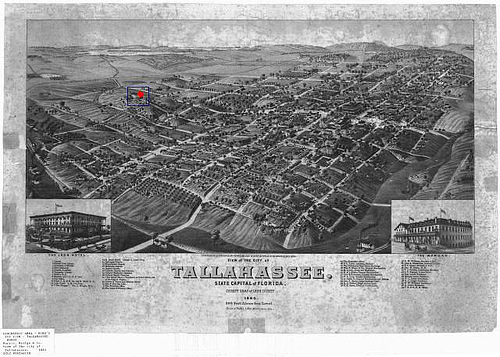
This map from the
Florida
State Archives illustrates that in 1885 the land we honor as Mina Jo
Powell
Alumni Green (red
dot) was a vacant lot at the edge of town. The
hilltop where Westcott and the plaza
fountain exist today is marked with a wooden-framed white structure. Curiously, the legend calls this schoolhouse
looking building the “University
of Florida.” In actuality, it would be the “West Florida
Seminary,” established in 1851-57.
In 1887, two years
after this map, The History of Florida Agricultural and
Mechanical University states that the Florida State Legislature
established
a college for African-Americans, called the “State Normal
College
for Colored
Students.” It chose a site “west of
Tallahassee on a commanding hill which now is the home site of Florida
State
University.” Exact location is debatable.
Presumably, upon
this vacant land
adjoining the seminary the State Board of Education built two small
wooden
structures “equipped with fifty wooden desks.” FSU
historian Dr. Steve Edwards affirms, “FAMU was
founded on that
corner.” It is likely these humble structures marking the beginning of
FAMU
stood on Mina Jo Powell Alumni Green. In
1891, The Normal College moved to the Duval Plantation, FAMU’s present
site,
relinquishing its original so the State could establish the “Florida Female College.”
June 1950 was a
turning point in the history of this green.
It marked the end of a nearly five-decade long tradition of holding
commencement
ceremonies there. Mina Jo Powell
graduated that year with 665 other seniors.
That year’s ceremony included the first class of men who began as
freshmen in 1946—when the Florida State College for Women (revised from
“Florida Female College” in 1905) officially admitted
men and became Florida State
University. French Ambassador Henri Bonnet
delivered the
commencement address to the class.
Yet, to appreciate
fully the dimensions of
change underway at FSU, we need only to consider that the 1950’s
September
enrollment hit an all-time peak of 6,399. No
longer could this small green accommodate
graduating classes. The obvious choice was
to hold future
commencements at the newly completed Doak Campbell Stadium, dedicated
October
28, 1950.
From the
Tallahassee Democrat, the “Class
of 1950”
gathered in the green. Facing north,
Longmire
is the building.
Mina Jo Powell is among
these graduates.
(Photo: Democrat, June 7,
1950)
FSU’s ever-growing enrollment during the
ensuing decades brought
with it a need for more classrooms and dormitories.
To the dismay of many alumni, especially
graduates
prior to 1951—according to Mina Jo Powell—buildings seemed to wedge
themselves on
campus, unrestrained and with a blind eye toward history and tradition. On more than one occasion, that small
half-acre green attracted plans to use it as a building site. But each time—says James Melton, retired
Alumni Coordinator—Mina Jo Powell rallied to preserve it.
Finally, in 1990, the notion struck Melton
and President Sliger that IF the university dedicated that green in
someone’s
name, this, in all likelihood, would preserve it forever.
Mina Jo Powell tells the same story, recalling her conversation
with Melton in which he related President Sliger speaking to him,
“’Name it
after somebody and nothing can happen to it.’” She
humbly adds, though, “They picked a ‘nobody,’
they picked me.”
Therefore, November 10, 1991, was a turning point in the history of
this green. A plot of earth sometimes
referred to as “that lot next to Longmire”; or, “that lot behind
Psychology—you
know, by Epps.” It rarely received the
honor due it, such as “Alumni Green” or “Commencement Green,” says
Melton.
Dr. Steve Edwards, then-Dean of the Faculty in 1990, introduced
President Sliger at the ceremony.
President Sliger’s words are worth remembering—for more reasons than
one:
| Mina Jo you have
impressed us with your accomplishments, inspired us with you
leadership,
enriched us with your generosity and sustained us with your constant
loyalty
and now it is our turn. As President of
the Florida State University, I name this lovely green in your honor and
will place a sundial here to
mark this area and bear the message,
“The Mina Jo Powell Alumni Green dedicated in honor of the generations
of
students who find on this campus their sunny hours of learning and
friendship.” (“Naming
of Mina Jo Powell Alumni Green (November 10, 1991),” from
the “Bernard F. Sliger Collection,” Container: Box
14,
Folder 6; Extent: 3 items; Strozier,
Special Collections.) |
There is, however,
a problem: No sundial ever appeared, nor
anything else bearing such an inscription.
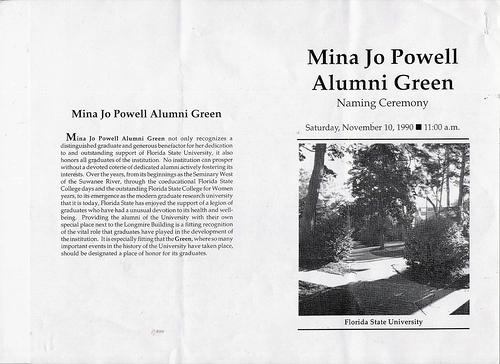
James Melton
advises that it is not too late to place a sundial in Mina Jo Powell
Alumni
Green, as promised, and have it inscribed.
Dr. Edwards
questions the accuracy of President Sliger’s speech found in the
archives at
Special Collections. He recalls drafting
the brochure and President Sliger’s words for the ceremony. Dr. Edwards believes that a sundial was never
intended for the Mina Jo Powell Alumni Green. He
suggests instead that a general staff member
compiled the notes of
the speech later from memory. He points
out that there is a sundial in front of Strozier Library, at Landis
Green, and
this is likely the sundial erroneously connected to Mina Jo Powell in
the
transcription of President Sliger’s speech.
Nonetheless, Mina
Jo Powell remains an impassioned and devoted supporter of FSU. In the Florida State University
Medical School Magazine,
summer 2006 (28-9), we read
again of “Mina Jo Powell, With Gratitude.” It
records Ms. Powell among a short list of a
precious few who helped
get FSU’s new Medical
School
up and
running. Each donor contributed “in
excess of one-million dollars.”
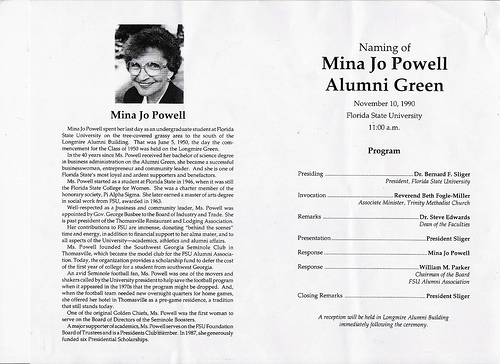
Preserving the green for future generations
took another positive turn
in October 2000. Sarah James (BS, 2002)
drew
inspiration to create a calm, contemplative site on campus after
experiencing the
lack of a serene place to remember students who died while attending
FSU. As a senator in the Student
Government
Association, she convinced the body to allocate $50,000 for a memorial. When James achieved this, the scope of the
monument and its location was undecided. Mina
Jo Powell Alumni Green was one of four
sites James and others considered—ultimately choosing this locale based
on its
central location and historically rich tradition.
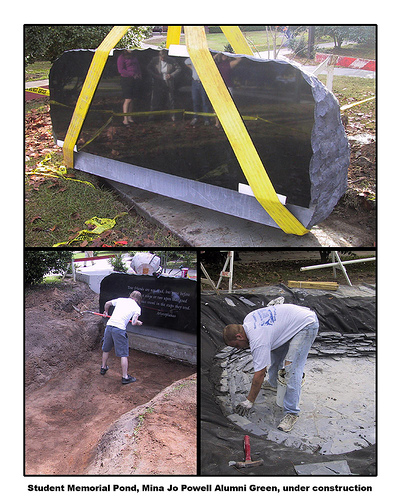 |
Mark
Bertolami of Campus Planning and Space
Management recalled James’s
quiet commitment and personal effort, summing, “She moved a mountain.” According to Bertolami and Robert Bischoff,
head of FSU’s Master Craftsman Studio, James’s humble resolve inspired
and
compelled their interest, and they contend that she, alone, brought
about the
“Memorial Fountain and Pond” in Mina Jo Powell Alumni Green.
A Memorial
that they agree incorporates the
serenity Sarah James
had envisioned with the assurance of the green’s preservation that Mina
Jo
Powell, James Melton, and President Sliger had dreamed.
Although originally planned, a ceremony
to
dedicate the Memorial apparently
never occurred. Sarah James graduated
and currently works in New
York City. As for
Mina Jo Powell, she said she is happy
to see this monument in the green that bears her name.
|
Bischoff arranged with a
monument company in Albany, Georgia
for the purchase and delivery of the 20-ton black granite rock from a
quarry in Africa.
It arrived by ship in Savannah,
a large square stone. Daryl Hall, of Albany, cut,
chiseled,
polished and inscribed it. Bischoff
recalled that setting the monument drew serious speculation and
eventually
loads of smiles and chuckles from staff and onlookers.
Everybody wondered how the crane’s straps
could come out from under the stone after it was set on the foundation. The workers nonchalantly put four plastic
bags of ice bought at a convenience store in between the monument and
slab. That ice held the massive stone
aloft long
enough to pull out the straps. It melted,
and the rock was set. Bischoff is sure
archaeologist will scratch their heads over how such cheerful looking
plastic ice
bags got under there.
Your Friends are not dead, but gone
before,
Advanced a stage or two upon that road
Which you must travel in the steps they trod
Aristophanes |
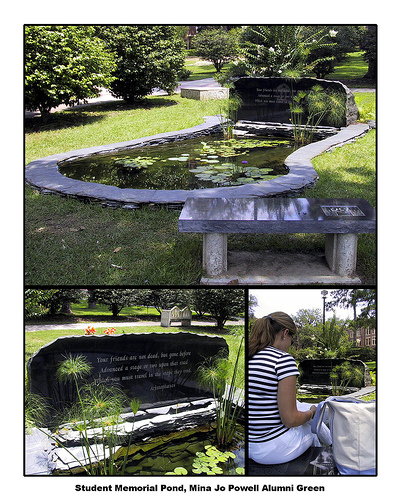
|
An immense,
double-seated stone bench sits in
Mina Jo Powell Alumni
Green—indeed, there are many like it elsewhere around campus—affiliated
with
the university’s bench-sponsoring program that honors faculty and
alumni. Looking straight at that bench,
the Memorial
monument is visible in its background—slightly beyond it.
This particular bench honors Mina Jo
Powell. Compared to other bench plaques
that extol dedications in paragraph-length versions, it is
conspicuously
plain. It simply reads:
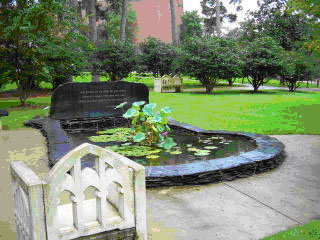
|
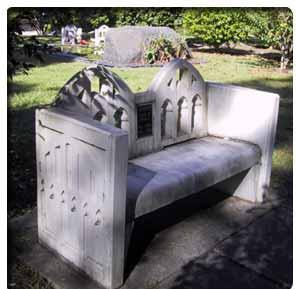 |
 |
Sarah
James and Mina Jo Powell
have never
met. Yet they share so much.
Someday maybe a bench dedicated to Sarah James will sit in this green.
|
The story about
this half-acre piece of turf known as Mina Jo Powell Alumni Green is
doubtlessly ongoing. Presently, there
are not any plans to add to it or build anything on it.
Across time—more than a century of which we
know—thousands of people have congregated on this small section of
earth. Some brought with them and others
created
enumerable cheers and tears upon this ground. What
would ghosts from the past want us to know
about this place? Would we see an
African-American pointing out
a blessed site where once stood a white, clapboard school?
An unassuming building in appearance, but with
rickety steps that once climbed led struggling generations far outside
its
single room and into arenas of opportunity that are vastly beyond any
physical
measurement?
From the first half of the
twentieth
century, what of the other Mina Jo Powells who received diplomas on
this green
and were challenged to go forth and make good things happen for
themselves and
others—what would they tell us now? And,
a little later on, as alumni who are more recent return to campus is
this one
of those life-defining places they seek to reconnect with who they
were?
Do they conjure in their memories choices
they planned, and others they made? And might
not these choices have complemented another, involving two lives, or
more—as parents
and as grandparents, they return where their children and children’s
children
attend?
There is no easy answer for these
questions.
But the green’s
evolution as a site
of memories for today’s students is stirring. Bob
Bischoff tells that the reflection pond in front
of the Student Memorial—strangely
enough—almost did not happen. There were
concerns that students would put soap in it. Bischoff
undertook a risky move that he believed
would tap the natural
kindness inside everybody. He stocked
the pond with fish. In over five years
now, there has never been the first drop of soap in that pond. Furthermore, he has seen students leaving for
summer, and after graduation, who set their own fish free there.
The Mina Jo Powell Alumni Green is
more than a lawn with benches and a monument—or mere green space
without a
building. Rather, in the imagination of students,
alumni, faculty, and administrators, it is a temple in the mind.
Sources:
Mark
Bertolami, Florida State
University Campus
Planning and Space Management, telephone discussions with the author,
September
21, October 3, 4, 2006. Additionally, in
file of author are email exchanges, October 3, 4, 5, 2006.
Robert
Bischoff, Florida State
University
Master Craftsman Studio, telephone and in-person discussions with the
author,
September 21, October 3, November 2, October 4, 2006, respectively. Additionally, in file of author are email
exchanges, September 22, 2006. The
Master Craftsman Studio provided the group photo of setting the “Memorial Monument” monument and its
counterpart
with grass shown around the pond.
Steve
Edwards, Jr., Professor Emeritus of
Physics and former-Dean of the Faculty, 1990, telephone discussions
with the
author, October 2, 3, 2006. Additionally,
in file of author are email exchanges,
October 4, 5, 10,
11, which include attachments of documents of memoranda with “Jim
Melton” and
recollections of the dedication of the Mina Jo Powell Alumni Green. Emails include discussions regarding the
sundial and origination of FAMU at the green.
Sarah James, telephone discussions with the
author, October 10, 11, 2006. Additionally,
in file of the author are email
exchanges, October 10, 12,
13, 2006, which include Web-link references to online-FSU Student
Government
Association minutes.
James
H. Melton, Special Projects Florida
State University Alumni Affairs, telephone discussions with the author,
October
17, 2006.
Leedell W.
Neyland
and John W. Riley, The History of Florida Agricultural and
Mechanical University (Gainesville: University of Florida Press,
1963), for
quotations see 10, 11, and for general reference see 12-33.
Mina Jo Powell, telephone discussion with
the author, October 17, 2006.
Maxine Stern, editor, FSU Voices: An Informal History of
150 years, 1st
edition (Tallahassee:
Florida State University Press, 2002), reference to “first class of
men” in 1950,
see section titled “End of an Era.”
The Tallahassee
Democrat, “Enrollment at
Peak; Major Building Program Is Underway,” B-1, December 31, 1950.
|

